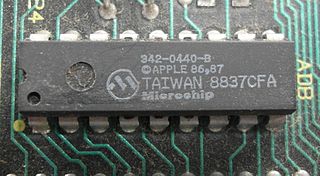
A field-programmable gate array (FPGA) is an integrated circuit designed to be configured after manufacturing. The FPGA configuration is generally specified using a hardware description language (HDL), similar to that used for an application-specific integrated circuit (ASIC). Circuit diagrams were previously used to specify the configuration, but this is increasingly rare due to the advent of electronic design automation tools.
Atmel Corporation was a creator and manufacturer of semiconductors before being subsumed by Microchip Technology in 2016. Atmel was founded in 1984. The company focused on embedded systems built around microcontrollers. Its products included microcontrollers radio-frequency (RF) devices including Wi-Fi, EEPROM, and flash memory devices, symmetric and asymmetric security chips, touch sensors and controllers, and application-specific products. Atmel supplies its devices as standard products, application-specific integrated circuits (ASICs), or application-specific standard product (ASSPs) depending on the requirements of its customers.

Cypress Semiconductor was an American semiconductor design and manufacturing company. It offered NOR flash memories, F-RAM and SRAM Traveo microcontrollers, PSoC programmable system-on-chip solutions, analog and PMIC Power Management ICs, CapSense capacitive touch-sensing controllers, Wireless BLE Bluetooth Low-Energy and USB connectivity solutions.

Altera Corporation was a manufacturer of programmable logic devices (PLDs) headquartered in San Jose, California. It was founded in 1983 and acquired by Intel in 2015.

PMC-Sierra was a global fabless semiconductor company with offices worldwide that developed and sold semiconductor devices into the storage, communications, optical networking, printing, and embedded computing marketplaces.
Lattice Semiconductor Corporation is an American semiconductor company specializing in the design and manufacturing of low power, field-programmable gate arrays (FPGAs). Headquartered in the Silicon Forest area of Hillsboro, Oregon, the company also has operations in Shanghai, Manila,Los Angeles and Singapore. Lattice Semiconductor has more than 700 employees and an annual revenue of more than $400 million as of 2019. Founded in 1983, the company went public in 1989 and is traded on the NASDAQ stock exchange under the symbol LSCC.
Conexant Systems, Inc. was an American-based software developer and fabless semiconductor company that developed technology for voice and audio processing, imaging and modems. The company began as a division of Rockwell International, before being spun off as a public company. Conexant itself then spun off several business units, creating independent public companies which included Skyworks Solutions and Mindspeed Technologies.

Wolfspeed, Inc. is an American developer and manufacturer of wide-bandgap semiconductors, focused on silicon carbide and gallium nitride materials and devices for power and radio frequency applications such as transportation, power supplies, power inverters, and wireless systems. The company was formerly named Cree, Inc.

Microchip Technology Inc. is a publicly listed American corporation that manufactures microcontroller, mixed-signal, analog, and Flash-IP integrated circuits. Its products include microcontrollers, Serial EEPROM devices, Serial SRAM devices, embedded security devices, radio frequency (RF) devices, thermal, power and battery management analog devices, as well as linear, interface and wireless products.
Actel Corporation was an American manufacturer of nonvolatile, low-power field-programmable gate arrays (FPGAs), mixed-signal FPGAs, and programmable logic solutions. It was headquartered in Mountain View, California, with offices worldwide. In November 2010, Actel was acquired by Microsemi for $430 million.

Lam Research Corporation is an American supplier of wafer-fabrication equipment and related services to the semiconductor industry. Its products are used primarily in front-end wafer processing, which involves the steps that create the active components of semiconductor devices and their wiring (interconnects). The company also builds equipment for back-end wafer-level packaging (WLP) and for related manufacturing markets such as for microelectromechanical systems (MEMS).

Broadcom Inc. is an American multinational designer, developer, manufacturer, and global supplier of a wide range of semiconductor and infrastructure software products. Broadcom's product offerings serve the data center, networking, software, broadband, wireless, storage, and industrial markets. As of 2022, some 78 percent of Broadcom's revenue was coming from its semiconductor-based products and 22 percent from its infrastructure software products and services.
onsemi is an American semiconductor supplier company, based in Scottsdale, Arizona and ranked #483 on the 2022 Fortune 500 based on its 2021 sales. Products include power and signal management, logic, discrete, and custom devices for automotive, communications, computing, consumer, industrial, LED lighting, medical, military/aerospace and power applications. onsemi runs a network of manufacturing facilities, sales offices and design centers in North America, Europe, and the Asia Pacific regions. Based on its 2016 revenues of $3.907 billion, onsemi ranked among the worldwide top 20 semiconductor sales leaders.

Cadence Design Systems, Inc., headquartered in San Jose, California, is an American multinational computational software company, founded in 1988 by the merger of SDA Systems and ECAD, Inc. The company produces software, hardware, and silicon structures for designing integrated circuits, systems on chips (SoCs), and printed circuit boards.

Littelfuse, Inc is an American electronic manufacturing company headquartered in Chicago, Illinois. The company primarily produces circuit protection products but also manufactures a variety of electronic switches and automotive sensors. Littelfuse was founded in 1927. In addition to its Chicago, Illinois, world headquarters, Littelfuse has more than 40 sales, distribution, manufacturing and engineering facilities in the Americas, Europe and Asia.
SiBEAM Inc., a wholly owned subsidiary of Lattice Semiconductor, is a fabless semiconductor company that provides integrated circuits and system solutions for millimeter-wave (mmWave) wireless communications and sensing.

MACOM Technology Solutions is a developer and producer of radio, microwave, and millimeter wave semiconductor devices and components. The company is headquartered in Lowell, Massachusetts, and in 2005 was Lowell's largest private employer. MACOM is certified to the ISO 9001 international quality standard and ISO 14001 environmental standard. The company has design centers and sales offices in North America, Europe, Asia and Australia.

LSI Logic Corporation, an American company founded in Santa Clara, California, was a pioneer in the ASIC and EDA industries. It evolved over time to design and sell semiconductors and software that accelerated storage and networking in data centers, mobile networks and client computing.
iCE is the brand name used for a family of low-power field-programmable gate arrays (FPGAs) produced by Lattice Semiconductor. Parts in the family are marketed with the "world's smallest FPGA" tagline, and are intended for use in portable and battery-powered devices, where they would be used to offload tasks from the device's main processor or system on chip. By doing so, the main processor and its peripherals can enter a low-power state or be powered off entirely, potentially increasing battery life.












